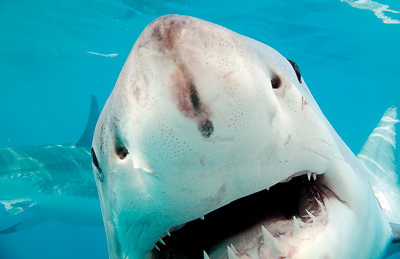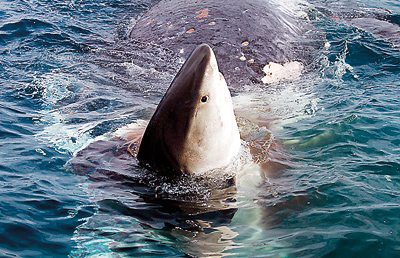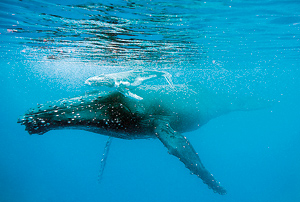Into the deep with the Great Whites
Underwater photography can be challenging and sometimes fraught with danger. Challenging because the fish /mammals are always on the move and it is difficult to compose a photo as we are not in our natural environment, and may have to swim pretty fast to keep up with them. Then there is the visibility factor in the ocean as well. Poor visibility means poor quality images.

The White shark: Determined to get inside the divers’ cage
Having seen a variety of sharks in real life, from the largest fish in the ocean, the whale shark, which is essentially a filter feeder reaching up to lengths of 15 metres to white tipped reef sharks and Wobbegongs that live on the ocean floor, I found the encounters with the Great White, the Bull Shark and the Humpback Whale and 10 day-old calf, the most satisfying experience of them all.
The Great White is known as the most feared predator of the ocean. They can be as large as six metres in length and reach speeds of 40 km per hour. During a cage dive in Port Lincoln, South Australia, we came face to face with this predator.
The Great Whites are attracted to the cage when pieces of fresh fish (bait) are tossed out into the ocean, close to the cage from the boat above. A piece of bait came floating inside the cage and the shark having a keen sense of smell and eyesight came charging at the cage. It rammed the cage to try and retrieve the bait and made a dent, tossing the cage that made us all go off balance and fall on the floor of the cage! The shark, it seemed was determined to get inside the cage.
During a shark dive in Pacific Harbour, Fiji, we came across a dozen or more Bull Sharks hovering above us. Bull sharks that could reach lengths up to four metres are found both in the sea and in fresh water. They are third on the list of predators that attack human beings after the Great White and the Tiger shark.

Tiger Shark surveying its surroundings after eating a dead Whale. Photo taken in Western Australia
While I was busy taking photos I noticed a Bull Shark coming towards me attracted by the reflection of the glass in the underwater housing of my camera. As it came too close for comfort, the Fijian diver with me used his metal staff to push the shark away.
If you are ever face to face with a shark never turn your back on it, always face the shark and if it comes too close push it away by its snout using a metal object or even your camera as the shark would not like the smell or taste of metal. Easier said than done but if all else failed I was prepared to shove my camera and housing into its mouth as it may have been a life or death situation.
My third most satisfying experience was swimming with the Humpback whales in Vavau, an island in Tonga. Humpback whales come to breed near the island off Vavau mainly because of the calm waters and the depth of the ocean where 200 metres from the shore, the ocean depth could be 500 metres.
I was on a Zodiac, which was powered by two outboard motors totalling 360hp and we were following a pod of Whales. As we spotted them I jumped out of the boat and came face to face with a mother Humpback whale and its calf which was only ten days old! It was a truly magnificent sight.
Humpbacks are harmless but do not allow you to get close to the pup, as was the case that day, where the father was following behind and would have definitely pushed us away if we came too close for comfort! My next trip and ambition is to photograph the Blue Whales in our very own waters off the coast of Mirissa.

A female Humpback whale and its ten day old calf


